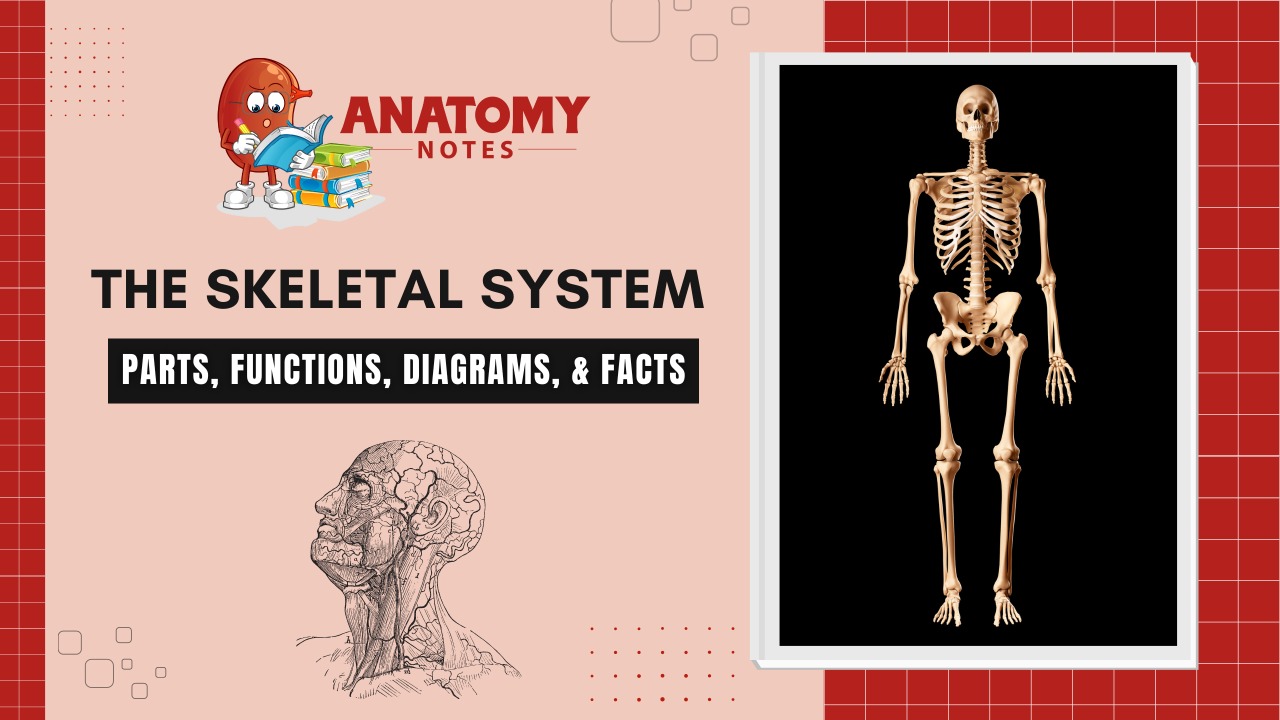The skeletal system is the internal framework of the body which provides support and protects the soft organs of the body.
The skeletal system is the collection of bones, cartilage, ligaments, and tendons and account for 20% body weight.
The skeleton is the structure that gives us our shape and offers a supportive framework for the attachment of muscles, therefore, facilitating movement.
Our bones also act as a site for the production of blood cells and a store of minerals, particularly calcium.
Functions of the Skeletal System:
The skeletal system is the body system composed of bones and cartilage and performs the following critical functions for the human body:
- supports the body
- facilitates movement
- protects internal organs
- produces blood cells
- stores and releases minerals and fat
Support, Movements & Protection
The most apparent functions of the skeletal system are the gross functions—those visible by observation.
- The bones support, facilitate movement, and protect the human body.
- Just as the steel beams of a building provide a scaffold to support its weight, the bones and cartilage of your skeletal system compose the scaffold that supports the rest of your body.
- Without the skeletal system, you would be a limp mass of organs, muscles, and skin.
- Bones also facilitate movement by serving as points of attachment for your muscles.
- While some bones only serve as a support for the muscles, others also transmit the forces produced when your muscles contract.
- From a mechanical point of view, bones act as levers and joints serve as fulcrums. Unless a muscle spans a joint and contracts, a bone is not going to move.
Mineral Storage, Energy Storage & Hematopoiesis
On a metabolic level, bone tissue performs several critical functions.
- For one, the bone matrix acts as a reservoir for a number of minerals important to the functioning of the body, especially calcium, and phosphorus.
- These minerals, incorporated into bone tissue, can be released back into the bloodstream to maintain levels needed to support physiological processes.
- Calcium ions, for example, are essential for muscle contractions and controlling the flow of other ions involved in the transmission of nerve impulses.
- Bone also serves as a site for fat storage and blood cell production. The softer connective tissue that fills the interior of most bone is referred to as bone marrow.
- There are two types of bone marrow: yellow marrow and red marrow. Yellow marrow contains adipose tissue; the triglycerides stored in the adipocytes of the tissue can serve as a source of energy.
- Red marrow is where hematopoiesis—the production of blood cells—takes place.
- Red blood cells, white blood cells, and platelets are all produced in the red marrow.
Anatomy of the skeletal system:-
The average human adult has 206 bones that are divided into two different parts, the axial and the appendicular skeleton:
Axial Skeleton:
The axial skeleton forms the axis of the human body. It consists of Skull, vertebral column, and thoracic cage.
- Skull: Skull is the most complex part of the human skeleton It consists of 22 different bones that are divided into two groups: bones of cranium and bones of the face.
- Vertebral Column: It is a flexible column of vertebrae, connecting the trunk of the human body to the skull and appendages. It is composed of 33 vertebrae which are divided into 5 regions: Cervical, Thoracic, Lumbar, Sacral, and Coccygeal.
- Rib Cage: It is a bony cage enclosing vital human organs formed by the sternum and ribs. There are 12 pairs of ribs that are divided into three groups: True ribs, False ribs, and Floating ribs.
Appendicular Skeleton:
It is the skeleton of appendages of the human body. It consists of the Shoulder girdle, Skeleton of the upper limb, Pelvic girdle and Skeleton of the lower limb.
- Shoulder Girdle: It attaches the upper limb to the body trunk and is formed by two bones: clavicle and scapula. The clavicle is a modified long bone and is subcutaneous throughout its position. It is also known as beauty bone. The scapula is a pear-shaped flat bone that contains the glenoid fossa for the formation of shoulder joint. It possesses three important processes: Spine of scapula, Acromion process, and Coracoid process.
- Skeleton of Upper limb: The skeleton of each upper limb consists of 30 bones. These bones are Humerus, Ulna, Radius, Carpals, Metacarpals, Phalanges.
- Pelvic Girdle: There are two pelvic girdles (one for each lower limb) but unlike the pectoral girdles, they are joined with each other at the symphysis pubis. Each pelvic girdle is a single bone in adults and is made up of three components: Ileum, Ischium, and Pubis.
- Skeleton of the Lower limb: The skeleton of each lower limb consists of 30 bones. These bones are Femur, Tibia, Patella, Tarsals, Metatarsals, Phalanges.
Frequently Asked Questions (FAQs)
What are the 5 primary components of the skeletal system?
The skeletal system has five main parts: bones, cartilage, ligaments, tendons, and joints. Bones provide structural support and protection, while cartilage cushions and absorbs shock. Connective tissues known as ligaments and tendons serve to attach bones to each other and to muscles. Joints allow for movement and flexibility.
What are the parts of the skeleton?
The human skeletal system consists of two primary divisions: the axial skeleton and the appendicular skeleton.
Axial skeleton: The axial skeleton is composed of the skull, vertebral column, and rib cage.It offers a safeguard and shelter for the crucial organs of the body. The skull serves to protect the brain and provide support to the face. The vertebral column, also known as the spine, offers support to the body and safeguards the spinal cord. The heart and lungs are protected from harm by the rib cage.
Appendicular skeleton: This includes the bones of the arms, legs, shoulder girdle, and pelvic girdle. The shoulder girdle supports the arms and allows for their movement. The pelvic girdle supports the legs and connects the lower limbs to the axial skeleton.
What is called a skeleton?
A skeleton is the internal framework of bones, cartilage, and other connective tissues that support and protect the body of an animal, including humans. The skeleton provides a structure for muscles to attach to and enables movement, while also protecting vital organs such as the brain, heart, and lungs. It also serves as a storehouse for minerals such as calcium and phosphorus, and plays a role in blood cell production.
Which bone protects the brain?
The skull, also known as the cranium, is the bone that protects the brain. It is a bony structure that surrounds and encloses the brain, providing it with physical protection from external forces that could cause damage. The skull is composed of several bones that are fused together, including the frontal, parietal, temporal, occipital, sphenoid, and ethmoid bones. The skull also contains several openings and cavities, such as the orbits for the eyes, the nasal cavity, and the ear canals.
What is bone made of?
Bone is a complex living tissue made up of several components. The main component of bone is a mineral called hydroxyapatite, which gives bone its hardness and strength. Hydroxyapatite is a crystalline form of calcium phosphate that is deposited in a matrix of collagen fibers.
The collagen fibers provide flexibility and resilience to bone, allowing it to withstand stress and strain. Bone also contains living cells, including osteoblasts, osteocytes, and osteoclasts, which are responsible for maintaining and remodeling bone tissue throughout life. Additionally, bone contains blood vessels, nerves, and other connective tissues that support its function and growth.
What is the main bone function?
The main function of bones is to provide support and structure to the body. Bones serve as a framework for muscles to attach to, which allows for movement and locomotion. Additionally, bones protect and support internal organs, such as the brain, heart, and lungs.
Bones also play a role in mineral storage and release, as they contain a significant amount of calcium, phosphorus, and other minerals. They serve as a reservoir for these minerals, releasing them into the bloodstream when needed to maintain proper levels in the body.




